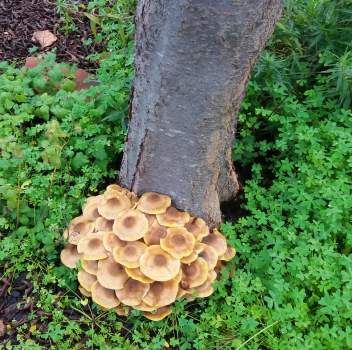Alameda Sun, Friday, December 20, 2019
by Marla Koss

A telltale sign of oak root fungus is a cluster of honey-colored mushrooms.
Alameda’s garden soil may be tops for cultivating and planting in, but it does have a significant drawback: it harbors oak root fungus Armillaria mellea. Do not confuse this with “sudden oak death” Phytopthora ramorum.
Armillaria is a serious forest pathogen common throughout California, having evolved to live where native oaks have grown. It is a long-lived, parasitic fungus that survives off dead root material, eventually killing a susceptible host. It does not affect oaks unless they are already stressed by disease or overly-watered lawns underneath the canopy.
Armillaria spreads underground through the root systems of healthy oaks as well as infected trees and plants of many species, searching for healthy root systems of other plants to infect. Signs can range from small, unhealthy leaves and lack of new bud growth at the height of summer to whole sections of the tree or bush dying suddenly.
The most telltale sign is a cluster of honey-colored mushrooms sprouting from the base of a tree or bush — or on a yet-to-be-removed section of dead tree root some distance away — just after the first rain in autumn or winter. Suspect Armillaria infection in a garden swath that has mysteriously lost otherwise healthy fruit trees, rose bushes, citrus, hydrangeas, lilacs, kiwis, blueberries or strawberries.
When it comes time to introduce a replacement, don’t plant it in the same area. When selecting a new fruit tree, pay attention to the rootstock the fruit tree is grafted onto. Fruit trees on susceptible rootstocks in non-infected ground are superb choices — e.g. citation or nemagard rootstocks for stone fruit — and they should be planted as far as possible from where the infection has been known to occur.
Otherwise, the best solution may be to purchase a tree with a rootstock that will resist the fungus. Dave Wilson Nursery, the wholesaler from which local nurseries receive much of their fruit tree and berry nursery stock, has a good rootstock comparison chart. Armillaria-resistant trees that grow beautifully in Alameda include persimmons, figs, low-chill apples and low-chill pears.
Currently, no effective fungicide control exists for California’s home gardeners. The most one can do to rid the area of infection is to remove all the roots of trees or plants killed by it, and dry the soil well. One valuable resource to check is “Plants Resistant or Susceptible to Armillaria mellea, the Oak Root Fungus” by Dr. Robert D. Raabe of The Department of Environmental Science and Management, U.C. Berkeley.
Marla Koss is a volunteer with Alameda Backyard Growers, (ABG) a network of gardeners in Alameda interested in growing food and donating fresh produce to neighbors who face food insecurity. Find the schedule for ABG’s monthly education meetings here.
